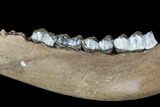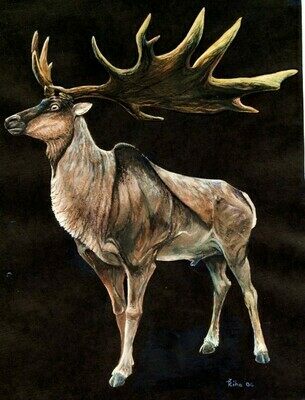This Specimen has been sold.
12.7" Irish Elk Jaw Section - Pleistocene, Germany
This is a nicely preserved, 12.7" long jaw of the extinct Irish Elk (Megaloceros giganteus) This fossil comes from the gravel deposits along the Rhine River in Germany and would be Pleistocene in age, about 40,000 years old. It would be from the lower jaw of an adult animal. Comes with a display stand.
Megaloceros giganteus was a giant prehistoric deer with antlers that could grow up to 12 feet across. It's estimated that they could have attained a body mass of nearly 1,500 pounds, roughly equivalent to an Alaskan Moose. The most recent remains of the species have been carbon dated to about 7,700 years ago in Siberia.
The Rhine River gravel deposits date from between 250-10k years old. This jaw was found sometime ago when these deposits produced higher quality fossils. Today the gravel quarries and river dredges in Europe are more mechanized and more destructive to fossils and mining methods in the past.
Megaloceros giganteus was a giant prehistoric deer with antlers that could grow up to 12 feet across. It's estimated that they could have attained a body mass of nearly 1,500 pounds, roughly equivalent to an Alaskan Moose. The most recent remains of the species have been carbon dated to about 7,700 years ago in Siberia.
The Rhine River gravel deposits date from between 250-10k years old. This jaw was found sometime ago when these deposits produced higher quality fossils. Today the gravel quarries and river dredges in Europe are more mechanized and more destructive to fossils and mining methods in the past.
SPECIES
Megaloceros giganteus
LOCATION
Rhine River Gravel Deposit, Germany
SIZE
12.7" long
CATEGORY
ITEM
#87468
We guarantee the authenticity of all of our specimens.
 Reviews
Reviews















